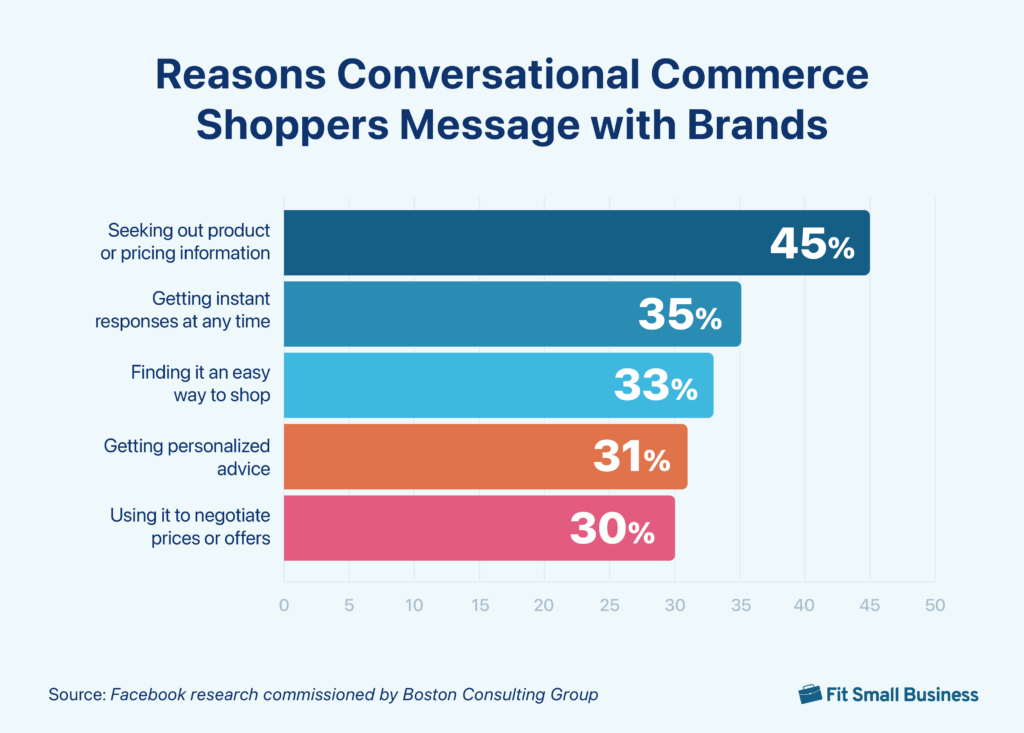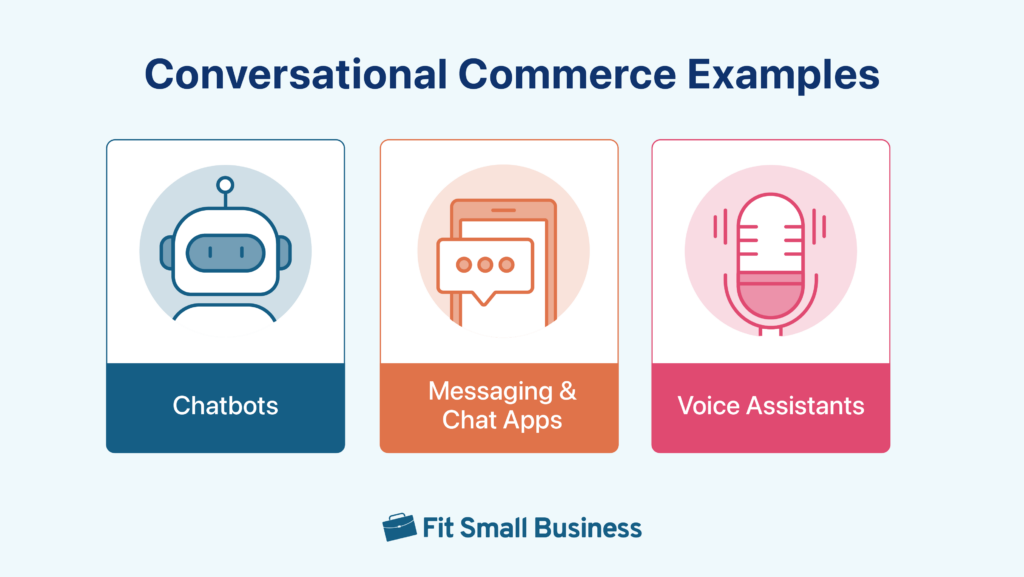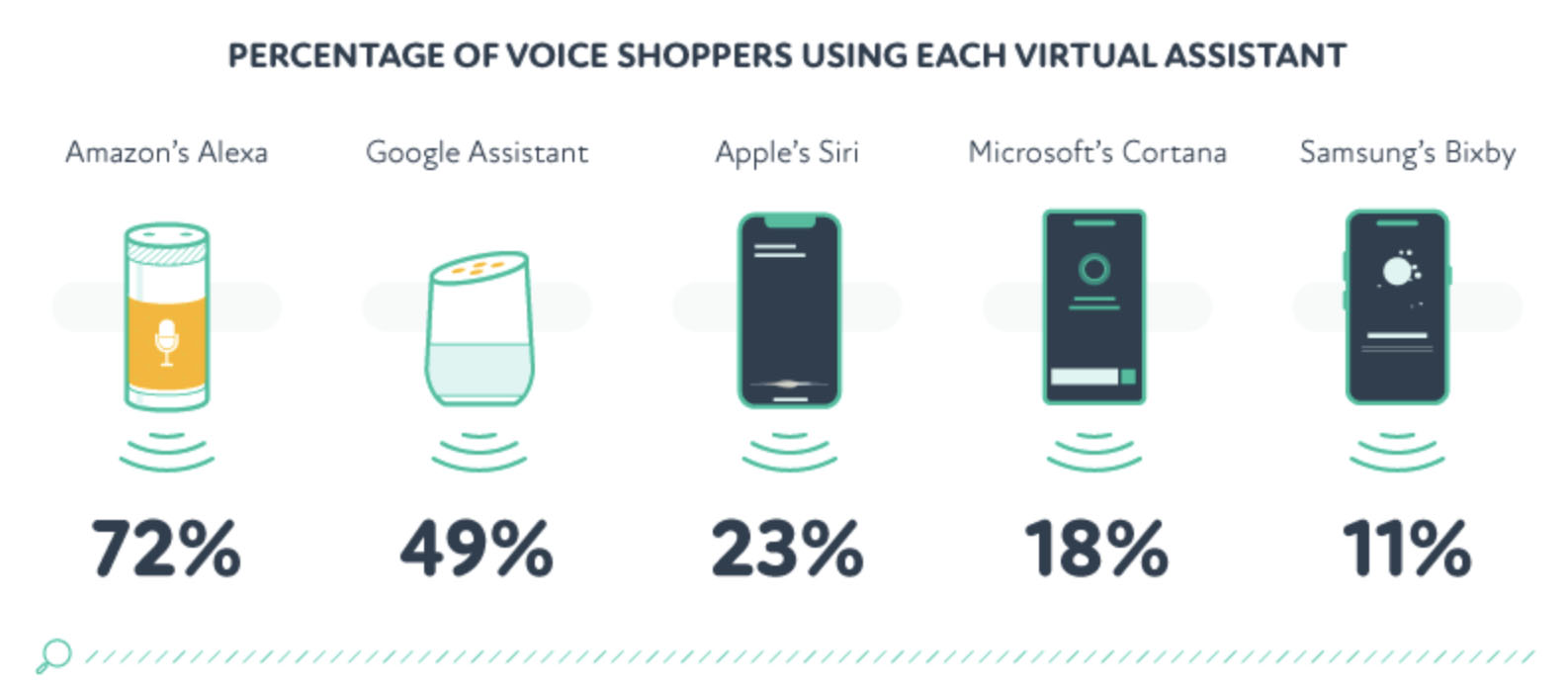Conversational commerce (also called c-commerce) is when consumers and brands connect through chat or voice assistance with the primary goal of making a purchase. Conversational commerce has gone mainstream thanks to artificial intelligence (AI) technology. The global c-commerce market is forecast to reach $34.41 billion by 2034.
In this article, we’ll take a closer look at what conversational commerce is, discuss its impact on ecommerce, explore the different types, learn about its many benefits and how to get started, and go over a few use cases.
Key Takeaways:
- Conversational commerce is making a big impact on the future of ecommerce. It drives higher spending and creates new online shoppers because of the ease of use of chat and messaging apps.
- Chatbots, voice assistants, and messaging apps are the primary types of conversational commerce.
- Improving customer retention, increasing your bottom line, and enhancing customer experience are just a few benefits of c-commerce.
Conversational Commerce Overview
Conversational commerce, by definition, is when brands and consumers connect through chat, messaging apps, or voice assistants with the intent to motivate the purchase of items or services. Through direct interactions with conversational commerce tools, brands can provide personalized suggestions, offer relevant assistance, and simplify the buying process.
The advent of the digital age opened a new opportunity for engaging with customers. With people always on the move and constantly online, customers prioritize speed and convenience even when it comes to shopping.
Conversational commerce provides the best of both worlds for in-store and online shopping. By using chat, you can ask for help when it comes to comparing product options—similar to how you would approach a sales associate in-store—but immediately, anytime, and anywhere, because of AI and technology, and then complete your purchase within the messaging platform, just like how you can shop conveniently online.
Overall, conversational commerce, like recent online shopping trends, centers around convenience and personalization.
Here are some conversational commerce examples showing how it is used in retail and ecommerce:
- Search for products and add them to cart with a voice command
- Respond to inquiries on social media messaging channels about pricing and services
- Get help during product search, discovery, and comparison with chatbots
- Request a ride from Uber through Facebook messenger
- Book an appointment with a spa or salon using messaging apps
Conversational Commerce: Impact on Ecommerce
The global conversational commerce market is forecast to reach $7.61 billion in 2024 and estimated to have a 16.3% compound annual growth rate from 2024 to 2034, reaching $34.41 billion by 2034.
The numbers clearly indicate how conversational commerce will become a mainstream way to shop online for consumers in the coming years. Sixty-seven percent of buyers surveyed by the Boston Consulting Group for Facebook research say they plan to increase or maintain their spending on conversational commerce.
- C-commerce guarantees convenience and personalized shopping assistance. Conversational commerce shortens the distance between wanting and having, as consumers can take charge and directly message brands when they have questions about their products. Brands, in turn, leverage AI technology, to provide immediate support and answers 24/7. This simplifies the buying process and personalizes and improves the shopping experience.

- C-commerce creates new online shoppers. Facebook research shows that conversational commerce is bringing Baby Boomers into the ecommerce world. They can find ecommerce websites challenging, but can easily chat—making it their new favorite way to shop!
Forty percent of conversational commerce buyers surveyed around the world say that chat was how they first started shopping online.
- C-commerce is expanding ecommerce with higher spending. The same Facebook research revealed that consumers develop relationships with brands via conversations or messaging. This, in turn, creates brand loyalty and equates to more frequent buying. Meanwhile, brands get more insight (data) into consumer profiles through these interactions so they can make more effective personalized recommendations. Consumers, in turn, tend to spend more because they receive offers catered to their preferences.
Conversational Commerce vs Conversational Marketing
Quick Take: Conversational marketing is about assistance and relationship-building, while conversational commerce focuses on enabling transactions within the conversation. Both harness the power of conversation to enhance the customer experience and drive results for businesses.
Conversational Marketing | Conversational Commerce | |
|---|---|---|
Focus | Building relationships | Purchases |
Approach | Omnichannel | Sales-focused channels |
Goal | Long-term engagement | Sales conversion |
Conversational commerce and conversational marketing are related concepts and are often used interchangeably. Both use conversations for customer engagement and employ the same tools—chatbots, live chat, and messaging apps—but have different focuses.
Conversational marketing involves customer engagement and relationship-building through one-on-one conversations. It aims to provide immediate assistance to customers and nurture long-lasting relationships with customers to develop brand loyalty.
Conversational commerce, on the other hand, involves interaction with customers in a way that enables them to transact with brands, such as purchasing products or services, directly within the conversation. It aims to create convenient, personalized, and seamless shopping experiences by integrating brands’ ecommerce platforms into their messaging channels.
Benefits of Conversational Commerce in Retail
Online shopping statistics show convenience remains the top consideration of consumers when shopping online. With conversational commerce, you can meet the consumer where they are, helping them decide and purchase within messaging platforms, without the need to go to another website and search for an item.
Conversational commerce in retail, in particular, has plenty of benefits. Some of them include the following:
Create Upselling & Cross-selling Opportunities
C-commerce can help increase average sales orders of customers by offering personalized recommendations. Upselling and cross-selling techniques can include a strategically placed web widget, a proactive notification, or an AI chatbot—all of which aim to engage with the customer and proactively offer more deals.
Learn more: Cross-selling Tips & Techniques for Retailers
Reduce Abandoned Carts
The shopping cart abandonment rate in the US is 72.74% (Dynamic Yield, March 2024). It remains a serious and persistent challenge for online retailers.
You can reduce abandonment rates through the help of conversational commerce by:
- Setting up proactive greetings via live chat to customers who have items in their carts but haven’t checked out their items by offering to help them complete their purchase
- Offering discounts to incentivize shoppers who have long-sitting items in their shopping carts
Related: Shopping Cart Abandonment Statistics to Know
Improve Customer Retention
Overall, conversational commerce, when done right, enhances the shopping experience and makes for satisfied and happy customers. Customer retention is easily achieved with great customer experiences.
Additionally, customers crave authenticity and personal interactions with brands. Messaging via web, mobile, and social channels is the best avenue for these experiences, making each interaction personal. This, in turn, cultivates brand loyalty and means a better bottom line for retailers.
Related: Customer Retention Rate: How to Calculate & Improve
Challenges to Conversational Commerce
While conversation commerce surely has plenty of benefits, it is not without challenges.
Lack of Human Touch/Interaction
Since conversational commerce heavily relies on AI and technology, there might be instances of language disconnect, misunderstanding context, perceived lack of empathy, and tech issues like systems not running properly. Brands should work with the most up-to-date tools available and have human support on standby in case the tools don’t work or have issues.
Siloed Data
One of the risks you run when implementing conversational commerce is having your data siloed. Conversations are usually confined to channels and cannot transfer between conversational commerce platforms, so it can lead to poor customer experiences.
Say you have a customer reach out to you on Messenger about a product inquiry. When you direct them to your website, they encounter a chatbot and unfortunately, would need to repeat themselves since the two platforms cannot sync together.
You can avoid this challenge by opting for a tool that easily integrates across channels. For example, Shopify’s chatbot, Shopify Inbox, can manage conversations from online store chat, Shop app, Instagram, and Messenger.
Types of Conversational Commerce
There are different types of conversational commerce models you can use for your ecommerce business.

Chatbots
Best for:
- Providing guidance by answering frequently asked questions
- Providing support by suggesting support articles for concerns or issues
- Providing product recommendations based on customer profile
A chatbot is an AI tool that simulates conversation. Chatbots can simultaneously chat with multiple people and provide information within seconds 24/7.
Conversational commerce bots can simulate human-like conversations with customers so they can answer frequently asked questions and assist with transactions. And because of AI, chatbots can identify customer preferences, track purchase history, and offer personalized recommendations.
Read more:
- Ultimate Guide to Ecommerce Chatbots
- Chatbot vs Live Chat: Which Is Best for Your Small Business?
- AI in Ecommerce: Small Business Guide
Voice Assistants
Best for:
- Answering simple and straightforward questions, usually about products, such as price and availability
- Product searches
A voice assistant is a tool that lets users perform voice commands to answer questions, search products, and complete transactions. Popular examples include Google Assistant, Amazon’s Alexa, and Apple’s Siri.
Through voice-based conversations, voice assistants enable voice commerce by allowing users to purchase products, find product information, and access services. Voice assistants are popular because they provide a hands-free shopping experience, intuitive interactions, and answer inquiries.

(Source: CouponFollow)
Read more: What Is Voice Commerce? Insights for Independent Retailers
Messaging & Chat Apps
Best for:
- Acquiring new customers
- Nurturing old and current customers
- Follow-up messaging on issues or concerns
Messaging apps are chat platforms that allow users to exchange instant messages. Many messaging apps have become increasingly relevant in the past years, even outpacing social networks with 20% more users. Popular messaging apps include WhatsApp, Messenger, and WeChat.
Now, businesses can use messaging and live chat apps to answer customer inquiries, provide product recommendations, and enable purchases, all within the same conversation. Since messaging apps can use GIFs and emojis in conversation, they create more personal and natural communication, which can translate into higher conversion rates.
How to Get Started With Conversational Commerce
Businesses can leverage c-commerce into their marketing and sales channels in different ways. However, it would depend on whether their ecommerce platform is equipped to integrate with a chatbot platform or support voice-powered purchasing functionality.
Here is a brief overview on how to get started:
Go with a platform where your customers regularly and already use.
- If you are going to use messaging apps, Messenger and WhatsApp have built-in features already, you just need to set it up for your business.
- If you are going to use chatbots, ensure your ecommerce platform can support the integration of a chat software or better yet, have built-in features for it. For example, Shopify—our top pick for best ecommerce platform—has Shopify Inbox, one of the free new Shopify AI tools.
- If you want to enable voice shopping for your online store, choose a voice assistant platform (Alexa, Siri, Google Assistant), integrate it with your ecommerce platform, and optimize your ecommerce store with natural language processing and more. Similar to how SEO works for website copy, there are ways to optimize your online store for voice search.
When choosing a platform, always consider your customers’ preferences and pain points so you can choose the best tools and technologies that can address their needs.
Once you have chosen your tool and platform, identify what types of inquiries and messaging your tool will handle and the language and tone it will use.
Determine how your tool will fit into your overall sales and marketing strategy. For example, use website chatbots to help customers during checkout, upsell, or promote special offers and discounts. Use social messaging apps to let followers know of limited promotions.
Conversational flows are how your conversational commerce tools talk and need to be similar or close to human interaction. Design a workflow that meets customers’ needs. Workflow maps help build out steps on how your tools can address customers’ questions throughout each touchpoint.
To improve and simulate more human-like conversations, leverage AI and machine learning. AI is only as good as the information you feed it with (or in this case, how much customers use the tool). Enter relevant information about your products and answer frequently asked questions about your business. This helps chatbots, voice assistants, and messaging apps get smarter and better at answering questions.
Once your tool has launched, pay close attention to any errors and areas that can be improved. Make adjustments as needed. For example, continually improve the language and conversational flows of your chatbots if you are deploying them. And train your employees on customer service in the event that there is an overflow of messages or an escalated concern so they can handle them better.
Conversational Commerce Use Cases
Here are some use cases on how brands can use conversational commerce to personalize experiences for their customers.

- Personal Shopping Assistants: Conversational commerce can come up with tailored product recommendations and expert advice to help customers make their purchasing decisions.
- Product Recommendations: With the help of AI, brands can make recommendations to customers based on their preferences, purchase history, and interactions. They can offer relevant suggestions, cross-sell or upsell products, and enhance the shopping experience with personalized recommendations.
- Order Placement and Management: Conversational commerce streamlines the buying process by allowing customers to buy, track orders, and receive real-time updates through interactive conversations.
- Payment Processing: Brands can integrate their payment gateways into chat platforms, making transactions quick, secure, and hassle-free for customers.
- Feedback and Reviews: Brands can collect valuable customer insights and sentiments through interactive conversations.
- Appointment Scheduling: Brands can offer a convenient and efficient way to book appointments, receive reminders, and manage customer schedules all within messaging platforms.
- Customer Support: With conversational commerce, brands can deliver instant and personalized customer assistance. They can address customer issues and concerns promptly.
Frequently Asked Questions (FAQs)
Click through the tab below to learn more about the most frequently asked questions about conversational commerce.
Conversational commerce is when consumers and brands connect through chat or voice assistance with the primary intent to drive purchases.
Conversational commerce enables real-time interaction between brands and consumers via messaging apps, chatbots, and voice technology. Mobile commerce, or mcommerce, is ecommerce done through handheld devices such as smartphones and tablets. The two are closely related since almost all consumers use messaging apps on their devices, providing a link between conversational commerce and mcommerce.
Conversational commerce examples include messaging apps, live chat, chatbots/AI, and voice assistants.
Conversational commerce enhances consumer shopping experiences, increases consumer spend, boosts customer engagement, and, overall, improves customer retention and satisfaction.
Bottom Line
Omnichannel shopping is crucial in today’s ecommerce landscape. People need to be able to shop whenever, wherever, and however they want—and that involves successfully getting answers, support, and assistance for purchasing decisions 24/7.
Conversational commerce lets brands deliver on all of these through technology-assisted conversations. With the help of messaging apps, chatbots, and voice assistants, conversational commerce provides a more streamlined and frictionless buyer experience and gives brands crucial insights into customer preferences through interactions.